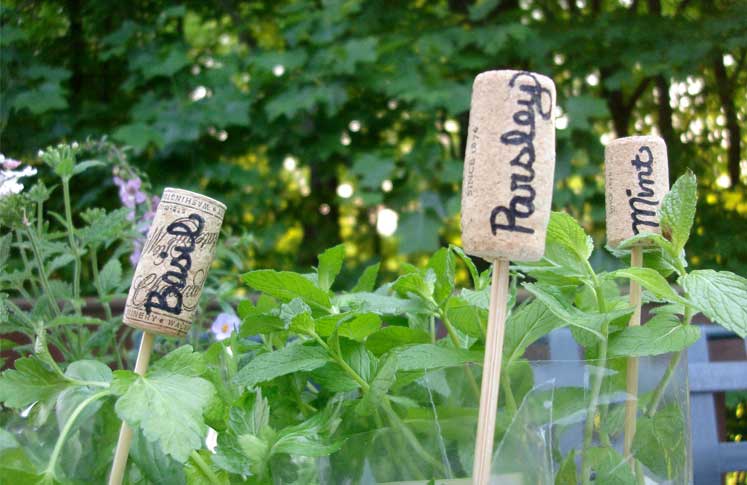First things first… Decide what you want to grow. Start with just a few plants that you know you’ll use regularly, and then explore new flavors and recipes. Your garden will grow from there.[/vc_column_text][vc_column_text]
| Herb | Special Care | How to Harvest | How to Use |
| Basil | Pinch off any flowers that appear. This preserves the plant’s flavor, and will also help increase the leaf density of each stem. | Harvest the upper leaves first, taking just a few leaves from each stem at a time. | Add raw to salads, sandwiches and wraps, cook into soups and sauces, chop and sprinkle on pizza, make pesto. |
| Parsley | Parsley has a longer than average germination period of three to four weeks, so extra patience is required. | Cut the outermost stalks just above ground level, which will encourage further growth. | Both the leaves and stalks can be eaten in salads, soups, and Mediterranean dishes like Tabouli. |
| Chives | If you don’t intend on eating the flowers, pinch them off as soon as they begin to appear. | Cut the leaves with scissors, starting with the outside leaves first, allowing about 2 inches of the leaves to remain. | This entire plant can be eaten from top to bottom— the bulbs taste like mild onions, the leaves can be used in salads and other dishes, and even the flower heads can be tossed into salads. |
| Cilantro | Cilantro does not like hot weather. If the soil temperature reaches 75 degrees, the plant will bolt and go to seed, making this a short-lived herb. Aggressive pruning will extend its life, so be ready to use or store it. Save the seeds to use in cooking (the seeds are called coriander) or to plant. | There are two methods of harvesting cilantro. When the plant reaches about 6″ in height, you can remove the outer leaves with a scissors, leaving the growing point intact for new growth. Or you can wait until the plant is almost completely grown and pull it from the soil by its roots to use the whole bunch at once. | Salads, wraps, dips, and many Mexican recipes. |
| Rosemary | This plant can be difficult to start from seed, so you may wish to buy a mature plant. And be careful not to overwater—rosemary likes its soil on the dry side. | Simply cut off pieces of the stem as you need it. | Many culinary and even medicinal uses. |
| Thyme | This plant can take awhile to start from seed, so you may wish to buy a mature plant. Drought-tolerant thyme is extremely easy to care for, and prefers drier soils. | Simply cut off pieces of the stem as you need it. | Often used to flavor meats, soups, and stews. |
| Dill | Drought-tolerant dill is extremely easy to care for, and prefers drier soils. | Don’t start harvesting dill until it’s at least 12 inches tall, and never take more than one-third of the leaves at any one time. | Great flavoring for fish, lamb, potatoes, and peas. |
| Mint | Mint is an invasive plant so stick to container gardening with this one. | Pinch off sprigs as you need them. | Mint is extremely versatile, and can be used in salads, desserts, drinks, and many other recipes. You can even chew it by itself for a pleasant, refreshing flavor. |
Decide whether you’ll start from seeds or seedlings. Seedlings are very young plants that you can transplant into your own garden. They are typically only available in the spring and summer from gardening centers and farmers markets. Seeds cost less, but take more time and resources to grow from scratch.
 Gather your materials. You’ll need a few gardening tools, like a small shovel or spade, some gardening gloves and pots or containers (optional since herbs can also be planted directly into the soil). You’ll also need some fertilized soil. If you have a compost pile, you can use some fully decomposed compost to fertilize the soil. Otherwise, you can use a general purpose compost solution, available in any gardening store. If you’re container gardening, use a packaged potting soil mix, which will be free of pests.
Gather your materials. You’ll need a few gardening tools, like a small shovel or spade, some gardening gloves and pots or containers (optional since herbs can also be planted directly into the soil). You’ll also need some fertilized soil. If you have a compost pile, you can use some fully decomposed compost to fertilize the soil. Otherwise, you can use a general purpose compost solution, available in any gardening store. If you’re container gardening, use a packaged potting soil mix, which will be free of pests.
Start planting. If you’re starting from seeds, sow into moist soil and cover with 1/2 inch of soil on top. The seeds should germinate in about one week. If you’re using a pot or container for seedlings, follow these steps.
- Ensure proper drainage by filling the pot with a shallow layer of course gravel.
- Fill the pot about 1/2 of the way full, and place the plant, still in its original container, into the new pot. Add dirt around the plant, gently packing it into place, so that the top of the new soil is at the same level as the top of the plant’s original soil.
- Remove the plastic pot, tap it so you can easily slide the plant and all of its soil out, and place the plant and all of its soil into the hole in the soil of the new pot.
Care for your plants. Water at the base of the plant when the soil begins to feel dry, at least once per week. Pull weeds that appear near the plant, because they will steal the nutrients from the soil. If growing outdoors, bring them in before the first frost.
 Harvest the herbs. Most plants will grow new leaves if you don’t pick the stems bare. You can pick the leaves with your fingers or snip them with kitchen shears.
Harvest the herbs. Most plants will grow new leaves if you don’t pick the stems bare. You can pick the leaves with your fingers or snip them with kitchen shears.
Use or store the herbs. Many recipes call for fresh herbs, so simply pick your herbs, wash them and pat them dry before using in your favorite recipes. To store, you can preserve your herbs for future use by freezing them or drying them. In either case, you must first prep them. First, remove any soil or bugs by rinsing in cold water. Then, remove flowering stems and flowers and gently remove excess water by patting with a paper towel. Once your herbs are prepped, you can choose your method of storage:
- Air drying: Cut the stems at soil level and hang upside down in bunches (so that the flavorful oil travels into the leaves) to dry for one to two weeks. Once dry, remove the leaves from the stems and store in a dry, airtight container for up to a year.
- Freezing: The benefit of freezing, as opposed to drying, is that the herbs retain more of their just-picked flavor. Place clean herbs directly into freezer bags, or try the cube method: Place a few teaspoons of chopped, fresh herbs into each cell of an ice cube tray. Fill the trays with water, and freeze. When cooking, just pop out a cube and add it to the pot like you would fresh herbs.














